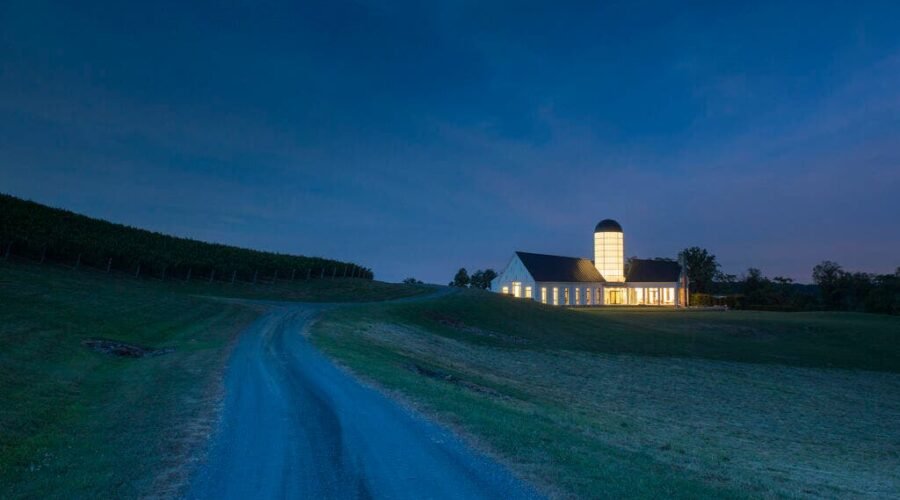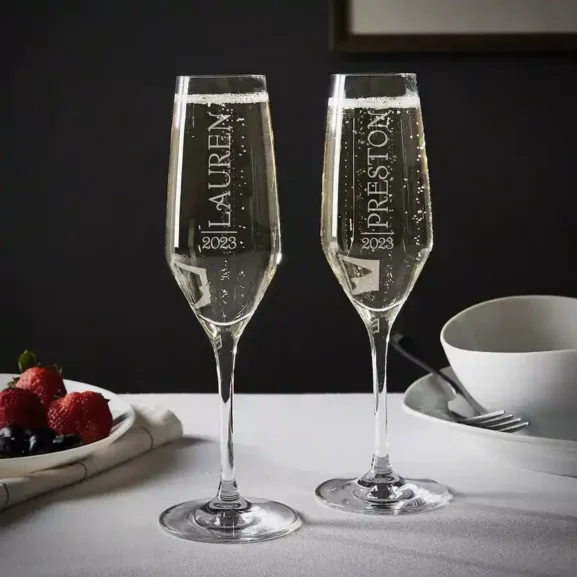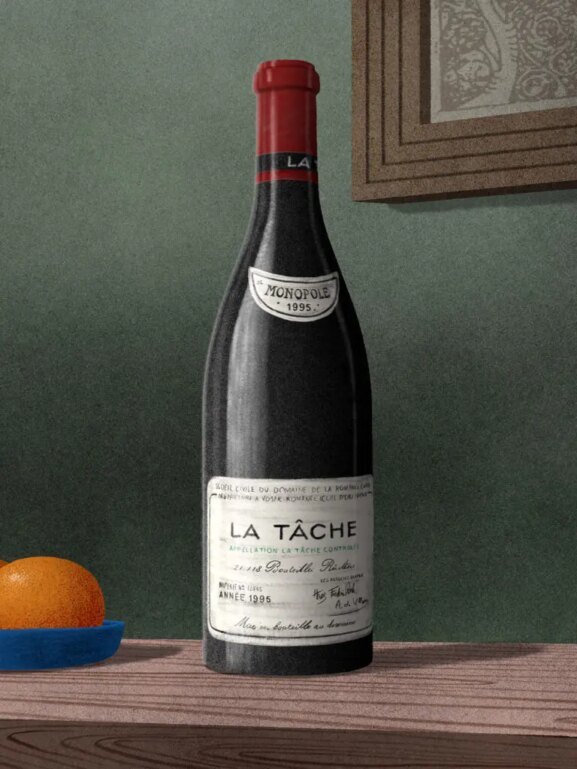Yes, the East Coast Is a Wine Region—and It’s Really Exciting
In 2003, Swiss-born, American-educated Rutger de Vink decided to quit his job in the financial industry and establish a European-style wine estate in Virginia—“an American cru,” as he put it. After interning or “staging” in top wineries such as Cheval Blanc in Bordeaux, Linden in Virginia and Ramey in California, in 2008 de Vink produced his first vintage of a red Bordeaux blend at his RdV Vineyards—named for his initials but also French slang for “rendez-vous”—in the rolling hills west of Washington, D.C.
De Vink succeeded perhaps beyond his greatest dreams. The wine trade in both France and the U.S. praised his wines, and today, collectors purchase them for more than $200 a bottle. Last summer, the Bouygues family, whose Eutopia Estates include Château Montrose in Bordeaux and Clos de Rougeard in the Loire Valley, purchased RdV for an undisclosed amount and renamed it Lost Mountain Vineyards.
Virginia Tourism Corporation, www.Virginia.org
While the French family first looked on the West Coast, “it was in Virginia—a still relatively discreet yet rapidly emerging wine region—that they found what they were looking for: a unique terroir, a compelling story and a pivotal human connection,” says Eutopia’s Maéva Senechau.
Although only a single transaction, the story is indicative of a much broader movement happening in the American wine world. The East Coast, from Virginia to New York, is now arguably the most exciting place to be for wine investors, winegrowers and wine lovers searching for great wines in their own backyards.
Earlier this year, Jon Ruel, CEO at Trefethen Family Vineyards and former head of Napa Valley Grapegrowers, became president of Early Mountain Vineyards. The showcase winery in the Blue Ridge foothills, Early Mountain was founded in 2012 by Jean Case, chair of the National Geographic Society, and her husband, Steve, co-founder of AOL. “I tasted the Early Mountain wines, and that was the catalyst,” Ruel says. “I decided after 20 years to get Napa Valley out of my system.”

Before Prohibition, the East Coast was a winemaking giant, but the grapes it grew—fruitier American labrusca varieties such as Concord—fell out of fashion, replaced by wines from vinifera vines grown in Europe and California. The East Coast was thought to be too cold and damp to grow vinifera, a belief dating back to Thomas Jefferson’s failure to do so.
Then a Russian émigré to New York’s Finger Lakes region upset that theory, establishing his now-eponymous Dr. Konstantin Frank winery in 1962 using vinifera vines. A decade later, in 1975, the influential Zonin winemaking family of Italy founded Barboursville Vineyards near Jefferson’s Monticello, a major financial gamble that great wines could be made on the East Coast. Both the Frank and Zonin ventures are flourishing today.

Best estimates say there are now about 1,400 wineries and 50,000 acres of vineyards in Virginia, Maryland, Pennsylvania, New Jersey and New York—the five states where East Coast fine winemaking is concentrated. While Pennsylvania might still be considered “emerging,” the state’s once-maligned wines are earning respect from top sommeliers. Even New Jersey has plenty of wines worth paying attention to.
“The East Coast has the climate for wine growing,” says Ed Boyce, co-founder of Black Ankle winery in Maryland, “but you have to find the best spots. Once we find those spots, you can make great wines.”
Getting the Word Out
For any wine region to advance from being backwater to center stage, it requires serious financial investment in vineyards, wineries, tasting rooms and event spaces, plus people experienced in making and marketing. There also has to be a customer base that appreciates fine wines, and this is the East Coast’s ace in the hole—there are about 50 million residents living in the coastal corridor between Richmond and Boston that also encompasses Washington, D.C., Baltimore, Philadelphia and New York City.

To give a few examples of how these elements are all coming together, international winegrower Paul Hobbs, who has received 100-point scores for his California wines, recently established Hillock & Hobbs Estate on Lake Seneca to make Riesling.
// Create the element
var script_68aa0fe80dcdc = document.createElement(“script”);
script_68aa0fe80dcdc.innerHTML = `
window.googletag = window.googletag || {cmd: []};
googletag.cmd.push(function() {
var adType = “leaderboard”;
var mapping;
var lbmapping = googletag.sizeMapping()
.addSize([1024, 0], [[970, 250], [970, 90], [1, 1], [728, 90]])
.addSize([728, 0], [[728, 90], [1, 1]])
.addSize([320, 0], [[1, 1], [300, 50], [300, 100], [320, 50], [320, 100]])
.addSize([0, 0], [[1, 1], [320, 50]])
.build();; // Size mapping for leaderboard ads
var medrecmapping = googletag.sizeMapping()
.addSize([1024, 0], [[300, 600],[300, 250]])
.addSize([728, 0], [300, 250])
.addSize([320, 0], [[1, 1],[300, 250]])
.addSize([0, 0], [[1, 1], [300, 250]])
.build(); // Size mapping for med rectengle ads
if(‘/39808611/article_page/article_leaderboard_1’ == ‘/39808611/article_page/article_leaderboard_1’
|| ‘/39808611/article_page/article_leaderboard_1’ == ‘/39808611/article_page/article_leaderboard_2’
|| ‘/39808611/article_page/article_leaderboard_1’ == ‘/39808611/article_page/article_leaderboard_3’) {
mapping = googletag.sizeMapping()
.addSize([1920, 0], [[728, 90]]) // >= 1920px
.addSize([1440, 0], [[728, 90]]) // 1440px-1919px
.addSize([730, 0], [[300, 250]]) // 730px-1439px
.addSize([0, 0], [[320, 100], [320, 50], [300, 100], [300, 50], [300, 250]]) // Up to 729px
.build();
} else {
mapping = adType == ‘leaderboard’ ? lbmapping : medrecmapping;
}
googletag.defineSlot(‘/39808611/article_page/article_leaderboard_1’, [],
‘div-gpt-ad-68aa0fe80dcdc’).addService(googletag.pubads()).defineSizeMapping(mapping);
googletag.pubads().enableSingleRequest();
googletag.pubads().collapseEmptyDivs();
googletag.display(‘div-gpt-ad-68aa0fe80dcdc’);
});
`;
// Append the script to the body
document.body.appendChild(script_68aa0fe80dcdc);
A German entrepreneur, the late Christian Wölffer, along with German winemaker Roman Roth pioneered the Hamptons area of Long Island with their showcase Wölffer Estate.
After helping establish Bouchaine Vineyards in California, Cintas executive David Pollak founded his Pollak Vineyards west of Charlottesville.

Fourteenth generation Rhône Valley winegrower Louis Barroul partnered with American wine veteran Richard Rainey to establish Forge Cellars in the Finger Lakes.
The late Jack Kent Cooke, once owner of the Washington NFL football franchise, founded the acclaimed Boxwood Winery in the horse country of northeastern Virginia. Additionally, three of the most-famous French wine consultants, Michel Rolland, Eric Boissenot and Stephane Derenoncourt, all have had East Coast clients.
Grape Expectations
Another aspect of the excitement is that Eastern winegrowers are still discovering and experimenting with grape varieties.
Cabernet Franc, Merlot, Cabernet Sauvignon, Chardonnay and Sauvignon Blanc are still popular. But, in the Finger Lakes, the Georgian variety Saperavi is showing the world that the region can make substantial red wines, while Virginia winemakers have fallen in love with the once-obscure Petit Manseng from France and Albariño from Spain for white wines along with range of indigenous Italian grapes.

Early Mountain winemaker Maya Hood White uses multiple vintages of lees to make a richer Petit Manseng, “which has more stability than Chardonnay, so we get less wine variability.”
Luca Paschina, now in his 36th vintage at Barboursville, says, “Our visitors love our Vermentino and Fiano.”
Anthony Vietri, owner/vigneron of Va La Vineyards in southeastern Pennsylvania, says, “I must admit the trials and tribulations of growing Nebbiolo have just been withering,” but he has been successfully doing so for 30 harvests.

Black Ankle’s Boyce and his wife, Sarah O’Herron, have shown fine Syrah can be made in the East.
Wölffer’s “Summer in a Bottle,” an eye-catching Provençal-style rosé blend of Syrah, Grenache, Cinsault and Vermentino, was instrumental in launching the rosé craze in New York City restaurants back when it was released in 2013.
// Create the element
var script_68aa0fe80e423 = document.createElement(“script”);
script_68aa0fe80e423.innerHTML = `
window.googletag = window.googletag || {cmd: []};
googletag.cmd.push(function() {
var adType = “leaderboard”;
var mapping;
var lbmapping = googletag.sizeMapping()
.addSize([1024, 0], [[970, 250], [970, 90], [1, 1], [728, 90]])
.addSize([728, 0], [[728, 90], [1, 1]])
.addSize([320, 0], [[1, 1], [300, 50], [300, 100], [320, 50], [320, 100]])
.addSize([0, 0], [[1, 1], [320, 50]])
.build();; // Size mapping for leaderboard ads
var medrecmapping = googletag.sizeMapping()
.addSize([1024, 0], [[300, 600],[300, 250]])
.addSize([728, 0], [300, 250])
.addSize([320, 0], [[1, 1],[300, 250]])
.addSize([0, 0], [[1, 1], [300, 250]])
.build(); // Size mapping for med rectengle ads
if(‘/39808611/article_page/article_leaderboard_2’ == ‘/39808611/article_page/article_leaderboard_1’
|| ‘/39808611/article_page/article_leaderboard_2’ == ‘/39808611/article_page/article_leaderboard_2’
|| ‘/39808611/article_page/article_leaderboard_2’ == ‘/39808611/article_page/article_leaderboard_3’) {
mapping = googletag.sizeMapping()
.addSize([1920, 0], [[728, 90]]) // >= 1920px
.addSize([1440, 0], [[728, 90]]) // 1440px-1919px
.addSize([730, 0], [[300, 250]]) // 730px-1439px
.addSize([0, 0], [[320, 100], [320, 50], [300, 100], [300, 50], [300, 250]]) // Up to 729px
.build();
} else {
mapping = adType == ‘leaderboard’ ? lbmapping : medrecmapping;
}
googletag.defineSlot(‘/39808611/article_page/article_leaderboard_2’, [],
‘div-gpt-ad-68aa0fe80e423’).addService(googletag.pubads()).defineSizeMapping(mapping);
googletag.pubads().enableSingleRequest();
googletag.pubads().collapseEmptyDivs();
googletag.display(‘div-gpt-ad-68aa0fe80e423’);
});
`;
// Append the script to the body
document.body.appendChild(script_68aa0fe80e423);
Although Wölffer, Konstantin Frank and a handful of other East Coast wineries are distributed widely in the U.S., Europe and Japan, direct-to-consumer sales in tasting rooms and through wine clubs still drive the success of most Eastern wineries. Tasting experiences in ultra-modern facilities, such as the luxe barn-style space at RdV Vineyards or the European-inspired outdoor tasting rooms at Wölffer, rival those of California. “You won’t find many places these days serving wine in plastic cups,” says Barboursville’s Paschina.

Yet wine lovers can still discover small quality wineries in out-of-the-way places. Russell Moss, who has made wine in several countries, now does that at Milea Estate in the Hudson River Valley. “What makes the Hudson Valley so compelling is our boutique scale,” he says. “In a world where connoisseurs are searching for authenticity, the Hudson Valley delivers.”
Moss could just as well be talking about the whole East Coast.
More American Wine Coverage
- We rounded up the best wineries (and more) to visit in Texas right now.
- These are the best Virginia wines to drink right now, according to the WE Tasting Department.
- Spanning three states, Ozark Mountain is among the country’s largest (and most unlikely) AVAs.
- Your next wine country getaway should be to Michigan. Here’s where to eat, stay and drink around the Lake Michigan Shore AVA.
- In case you hadn’t heard, Southern California wines are having a moment.
- Here’s how Washington winemakers are taking Syrah to new heights.

From the Shop
Find Your Wine a Home
Our selection of red wine glasses is the best way to enjoy the wine’s subtle aromas and bright flavors.
The post Yes, the East Coast Is a Wine Region—and It’s Really Exciting appeared first on Wine Enthusiast.


